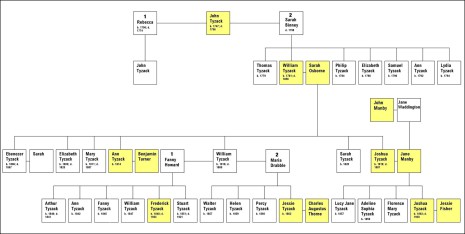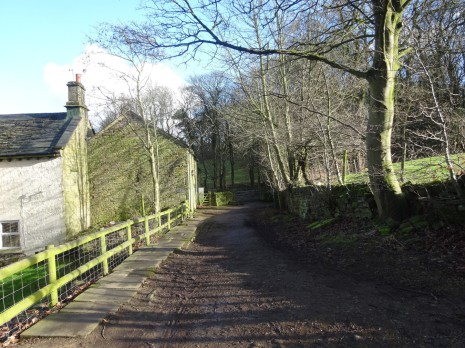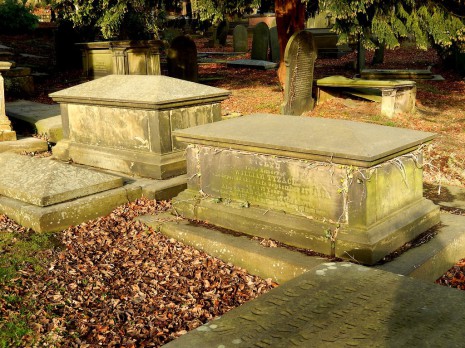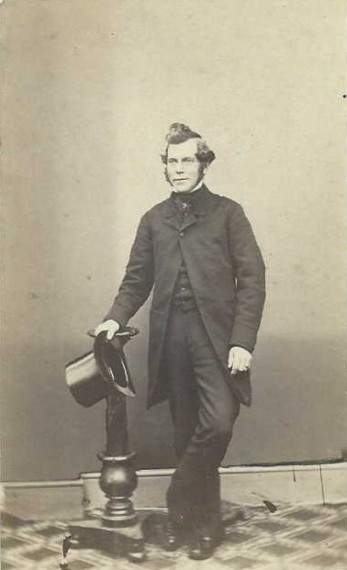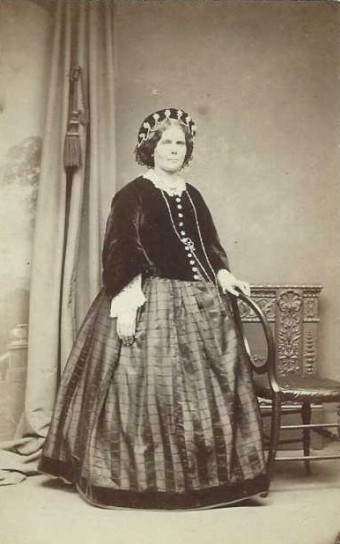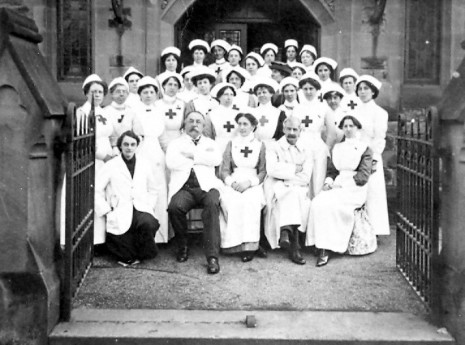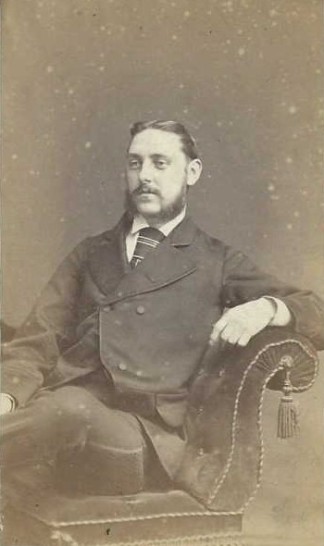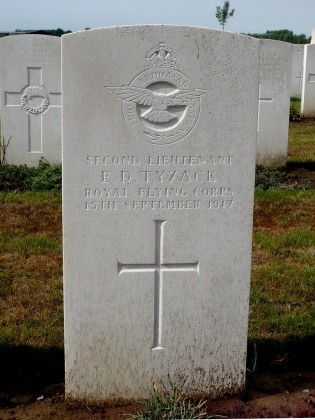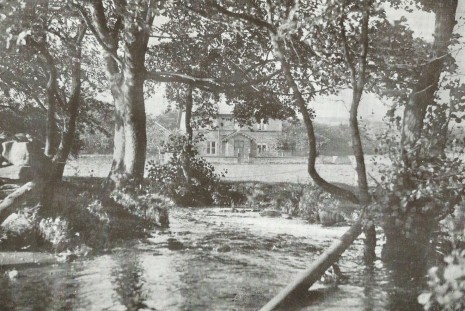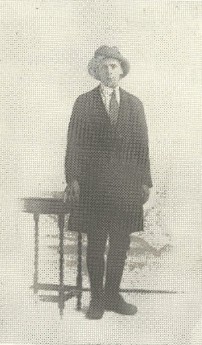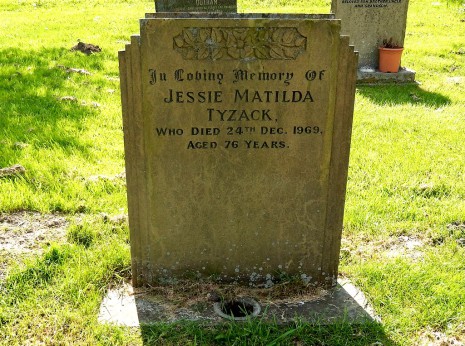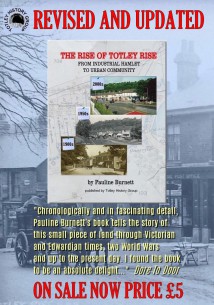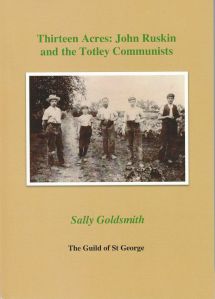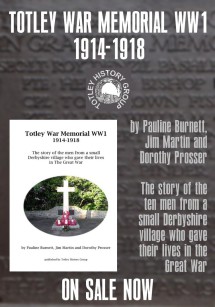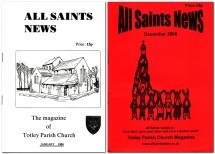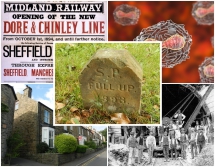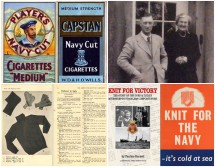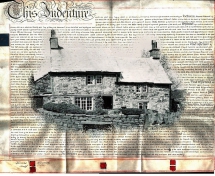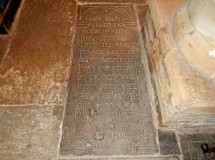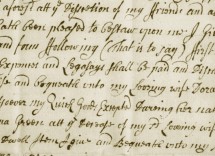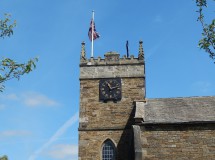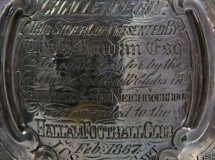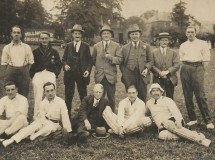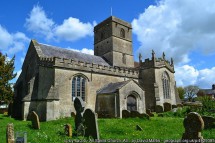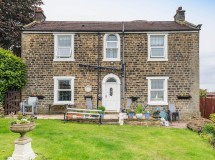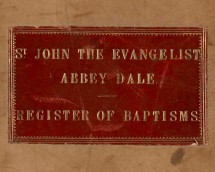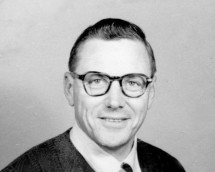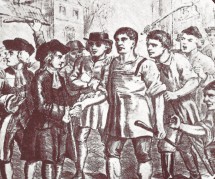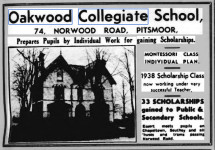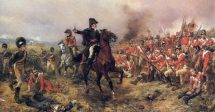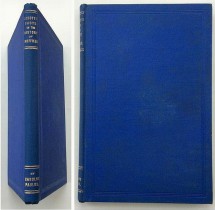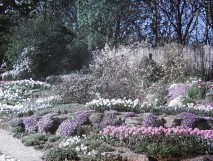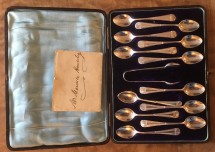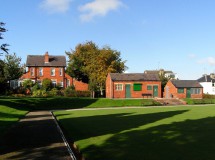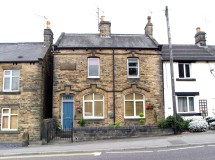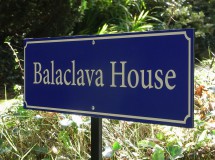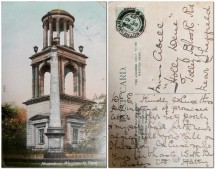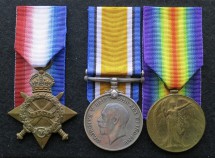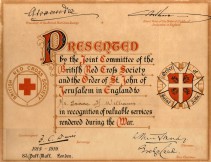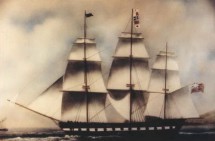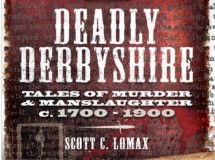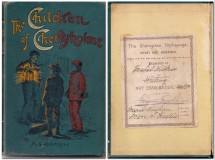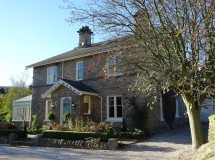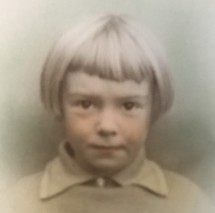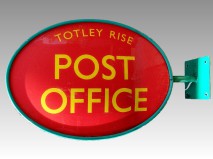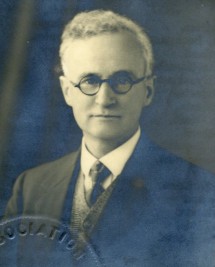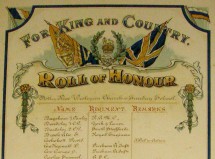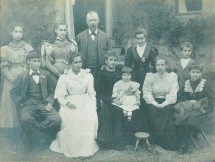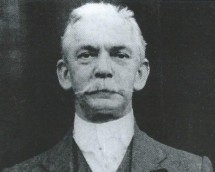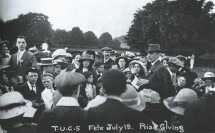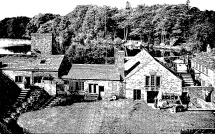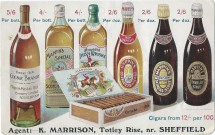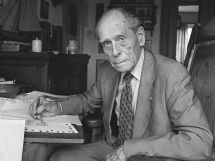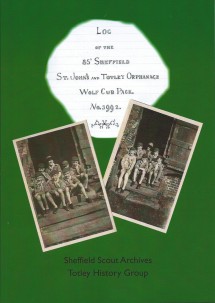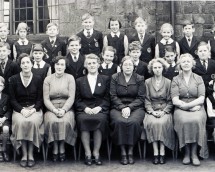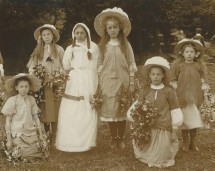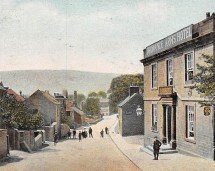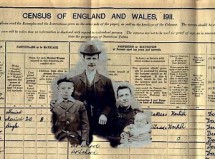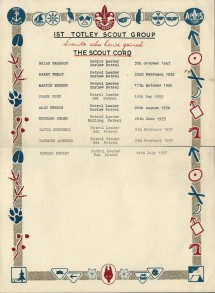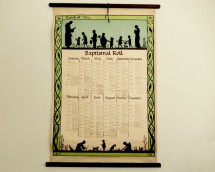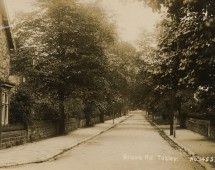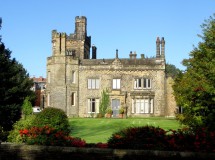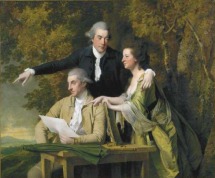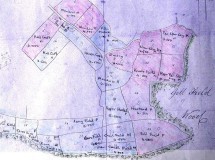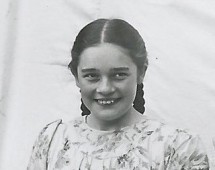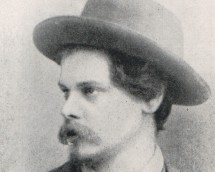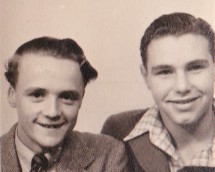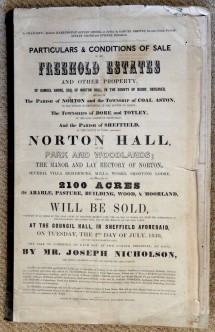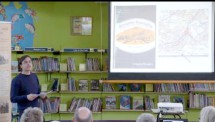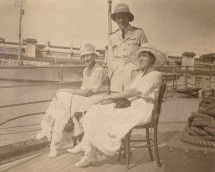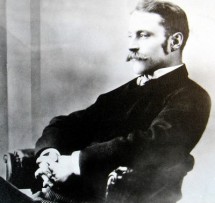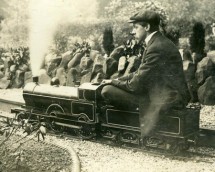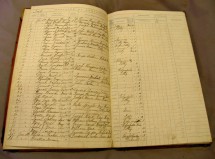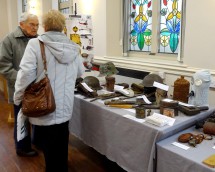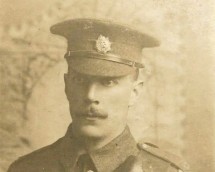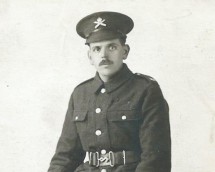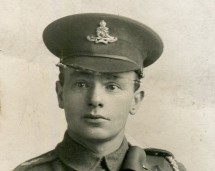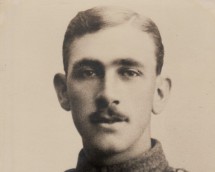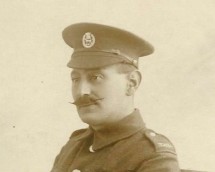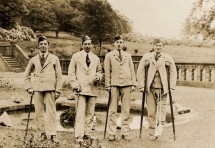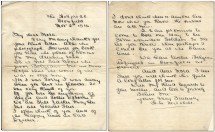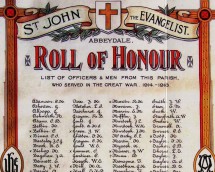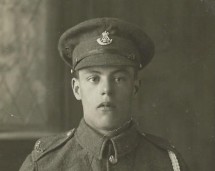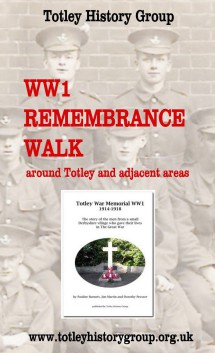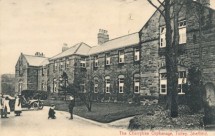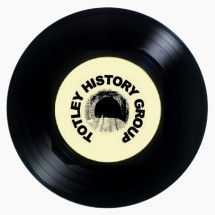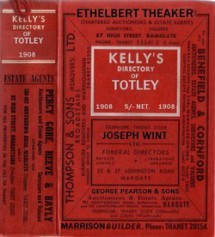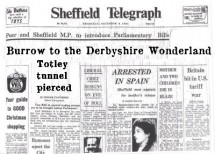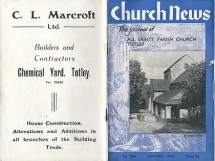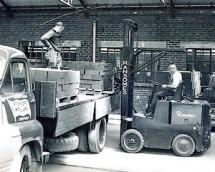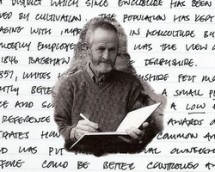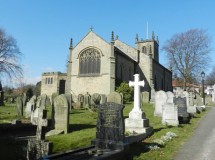The Tyzack Family
William Tyzack, the founder of the Tyzack Company, was born on October 3rd 1781. He was the second son of John Tyzack (2) and his second wife Sarah Binney who were married on March 20th 1775.
John Tyzack (2) was a farmer and part time scythe maker who was baptized at St John’s church Norton on November 21st 1747 the son of John (1)and Margaret Tyzack. John Tyzack (1) was a scythemaker and by 1746 he had taken a 42 year lease on the Walk Mill (which now lies under Dore and Totley Station) and that is where John (2) grew up. John Tyzack (1) died in 1755/56 at the young age of 36. He left a Will and there is also an Inventory which makes interesting reading. As an aside, in later years (1845) we find Walk Mill being leased by Thomas Tyzack the great grandson of John(1).
On June 1st 1772 at the age of 25 John (2) married Rebecca Binney who was not quite 16 years old! She was the daughter of Thomas Binney a wealthy man. He seems to have set up John (2) as a farmer and scythemaker on Trap Lane in Bents Green. On March 20th 1774 Rebecca gave birth to a son John (3). Sadly she died giving birth and was buried on March 25th1774 at Ecclesall All Saints. A year later on March 20th 1775 John (2) married Rebecca’s step-sister Sarah Binney probably with an eye to keeping his farm and inheriting some of Thomas Binney’s wealth in due course! Unfortunately marrying your dead wife’s sister was not permissable in Canon Law at that time but John got round this by obtaining a Licence to avoid having the Banns read and going to Handsworth to get married.
John and Sarah went on to have seven children, four sons - Thomas 1779, William 1781, Philip 1784 and Samuel 1790 - and three daughters - Elizabeth 1786, Ann 1792 and Lydia 1794. Two years after Lydia’s birth on July 17th 1796 John (2) died, he was buried at Ecclesall on July 19th. His wife Sarah died two years later and was buried at Ecclesall on August 9th 1798. The children seem to have stayed on at the farm, Rebecca’s son John (3) taking over the farming and Thomas and William becoming apprenticed as saw makers probably to men working at Thomas Boulsover’s rolling mill at Whiteley Wood which was a short distance from their home on Trap Lane.
On April 18th 1803 William Tyzack (1) married his cousin Sarah Osborne at the Cathedral Church of St Peter and St Paul in Sheffield. By the time William’s name appeared in the Sheffield Directory in 1817 the couple had two sons, Ebenezer and William (2) and three daughters, Elizabeth, Mary and Ann. When William (2) was baptized at Ecclesall church on June 9th 1816 his father’s occupation was given as Fendersmith - apparently this was someone who was employed to clean and repair the fenders in mansions, castles etc. In 1818 another son Joshua was born and in 1820 a daughter Sarah completed the family.
William and his older brother Thomas had set up as sawmakers in premises on South Street (which is now The Moor) by 1817. In 1821 they were also making patent scythes, busks and calico webs. (Busks were thin strips of steel used in ladies’ corsets and calico webs were thin strips of steel shaped into a narrow blade and used for cleaning calico). Around 1824/25 the brothers went their separate ways and William moved to other premises on Rockingham Street which was to be the headquarters of his firm for more than 50 years. He set up the firm of W. Tyzack at the Button Lane end of Rockingham Street and this later became W. Tyzack & Sons.
The business expanded rapidly and the premises were greatly enlarged. The range of products that they made expanded also. In 1831 a cast steel furnace with four pots was added. The Rockingham Street premises didn’t have enough facilities for all the output so William (1) started renting nearby mills and in 1831 he was a tenant of Whirlow Wheel on the Limb Brook. By 1843 William’s sons Ebenezer, William (2) and Joshua had joined the firm. In 1847 he left Whirlow Wheel and took the tenancy of Whiteley Wood works near the Porter. That William (1) was a keen fisherman is shown by his landlord John Fowler’s constant complaints about him fishing in the mill pond even though he had no rights to do so! Finally in 1849 William (1) took over the tenancy of Abbeydale Works from John Dyson.
On May 30th 1839 William (2) married Fanny Howard at the Cathedral church of St Peter & St Paul in Sheffield. Fanny was the daughter of Thomas Howard a gardener and lived on Garden St,Sheffield. On January 20th 1840 a son Arthur was born and in the1841 Census the baby was with his grandparents William (1) and Sarah at Bents Green. Sadly a few months later he died and was buried in Ecclesall churchyard on July 11th 1841. A year later a daughter Ann was born and she was followed by Fanny in 1845, William (3) in 1847, Frederick in 1848 and Stuart in 1851.
By the time of the 1851 Census William (1) and Sarah were living at Plumpton House in Bents Green with their unmarried daughter Mary aged 39, grandson Frederick aged 2 and a servant, Sarah Bower, who came from Totley. William (1) was described as a saw and file manufacturer employing 50 men. William (2) was by now living in the Manager’s House at Abbeydale Works along with his wife Fanny, four of his children including a 6 month old baby and his younger brother Joshua. No wonder that young Frederick was staying and possibly living with his grandparents!
On Sunday November 7th 1852 tragedy struck the family. Fanny Tyzack was nearing the time for the birth of her seventh child when she collapsed and died. The inquest gave ‘syncope, produced by natural causes’ as the cause of death. ‘Syncope’ seems to mean fainting as a result of low blood pressure but there was presumably more to it than that - possibly it was actually high blood pressure which caused preeclampsia? Certainly the newspaper reports imply that she had been unwell. Poor William (2) was in Glasgow on business at the time and the news was sent to him by telegraph. Fanny and presumably her unborn baby were buried at Ecclesall on November 14th.
William (2) must have managed with the help of family and servants over the next few years as it would seem that he was still travelling on behalf of the firm. However on August 14th 1857 he was married again to Maria Drabble and children arrived in quick succession - Walter on November 27th 1857! He was baptized at the Cathedral on April 2nd 1858. Helen (Ellen) arrived in October 1858, Percy in April 1860 and finally Jessie in 1862.
Joshua Tyzack the youngest of the brothers had also married on September 26th 1854 at Holy Trinity,Skipton. His bride Jane was the daughter of John Manby an old established customer of Abbeydale Works. He had been a customer of John Dyson and obviously continued the association with the Works after the Tyzacks took over and Joshua had met his daughter while on his sales trips.
In 1855 a steam engine was installed at Abbeydale to add to the considerable water power that was already available. In 1858 William Tyzack(1) died at the age of 77 and he was buried at Ecclesall All Saints on October 1st. His Will was proved on February 23rd 1859 by Ebenezer, William and Joshua Tyzack and Benjamin Turner. William (1)’s sons Ebenezer, William (2) and Joshua continued to run the company very successfully.
An ‘Eligible Country Residence’ had become available To Let in June 1858. This was Abbeydale House just across the road from Abbeydale Works. The property was to be shown by ‘Messrs Tyzack of the Abbey Dale Works’. William (2) obviously decided this would be ideal for his new wife and growing family and by early 1861 they were living there with the five children from his first marriage, the three from his marriage to Maria and two servants - Elizabeth Hammond a nurse maid and Sarah Clayton a house maid. Just around the corner at Wood Lodge on Abbey Lane was his sister-in-law Jane wife of Joshua who was away on Census night. He was staying at the Feathers Inn in Pocklington and his occupation was ‘Commercial Traveller in Ironmongery’. Sarah, aged 81 and widow of William (1) was still at Plumpton House with her unmarried daughter Mary. Sarah died at Wood Lodge on July 17th 1864 at the age of 84 and was buried at Ecclesall on July 20th.
Three years later in 1867 there was another death in the family, Ebenezer the eldest of the three brothers died and was buried at Ecclesall on April 29th. This resulted in the business being split up between the remaining two sons and their nephews. In 1837 William and Joshua’s sister Ann had married Benjamin Turner and in 1870 he was taken into partnership and their company became known as W. Tyzack, Sons and Turner.
After his marriage to Jane Manby in 1854 Joshua Tyzack either moved into or had built Wood Lodge on Abbey Lane. He had a chapel built in the grounds of his house which was opened for services on October 27th 1861. By 1875 three services on Sunday and an evening service on alternate Tuesday nights were being held. The evening services on Sunday and Tuesday were Anglican and the Sunday morning and afternoon services were conducted by preachers of the Methodist Reform Union.In 1874 Joshua was presented with a solid silver inkstand in recognition of his benevolence.
In 1871 William (2) and Maria Tyzack’s daughters Helen aged 12 and Jessie aged 8 were at a Ladies Boarding School in Bubnell near Baslow in Derbyshire. William (2) and Maria were still living at Abbeydale House with Ann, William (3), Frederick, Stuart and Walter and Sarah Wolstenholme a general servant from Totley.
Jane Tyzack was visiting her sister Eliza Paget in Skipton at the time of the 1871 Census. Joshua Tyzack was still travelling for the company and was staying at the Railway Hotel in York. Their daughters Adeline and Lucy were at boarding school on Wilkinson St in Broomhall, Sheffield and Joshua and Florence aged 8 and 10 were at ‘Abbeydale’ in the care of a 17 year old servant Ann Cowley! Their Aunt Mary was next door and these two households must have been Wood Lodge and Rockingham House.
In 1875 there was a wedding in the family when Joshua and Jane’s daughter Lucy married Douglas Parbury a wine merchant and they set up home in Norwood near Croyden. Sadly there was another family funeral in 1877 when Lucy’s 16 year old sister Florence died. She was buried at Ecclesall on August 14th.
The 1881 Census shows William and Maria still at Abbeydale House with their sons Stuart and Frederick and two servants. Joshua and Jane were still at Wood Lodge with their daughter Adeline and son Joshua and a servant. The next few years brought two family weddings. On August 31st 1881 Stuart Tyzack married Mary Ellen Meggitt at St Mary’s Church Barton -on-Humber in Lincolnshire and on February 28th 1883 his brother Frederick married Emily Delaney at St Andrew's Church in Sharrow.
By the late 1880s Joshua Tyzack’s health had been failing and he died at Wood Lodge on March 14th 1887 of congestion of the lungs. This was the day before what would have been his 69th birthday. He was buried at Ecclesall on March 17th and the funeral was a large one. As well as friends and family who followed the hearse in a dozen or so carriages the funeral was attended by about 300 employees of W. Tyzack, Sons & Turner. They walked at the head of the funeral procession as it passed up Abbey Lane to Parkhead and down to the church. They then lined the path to church as the coffin was borne past. It must have been rather a magnificent sight. He died a wealthy man and his bequests included £50 each to Jessop Hospital, Sheffield Public Hospital and Dispensary and Cherrytree Orphanage in Totley. In today’s money £50 would be about £5,000.
1889 was not a good year for the Tyzack family, On February 24th William,the last of the three Tyzack brothers, died at 7.30 in the morning. His funeral took place on February 28th and, as with his brother Joshua, the funeral procession was led by between 200 and 300 employees as it passed along the same route to Ecclesall Church. The wreaths included one from the men of Abbeydale Works. This was closely followed by the funeral of William Alexander Tyzack, son of Ebenezer and nephew of William (2) and Joshua, on December 26th 1889. Not a very cheerful Christmas for the Tyzack family.
Jessie, the younger of Joshua and Maria Tyzack’s daughters had married Charles Augustus Thorne in 1888 and they set up home at The Glen on Abbeydale Road South. Charles Thorne was a doctor and became well known locally. During WW1 he was the surgeon at the VAD Hospital in what is now the GPO Sorting Office next to St John’s Church.
In 1891 Maria Tyzack was at Abbeydale House with her children Walter, Helen and Percy and four servants. Her sister-in-law Jane was at Wood Lodge with her son Joshua and daughter Adeline and two
servants. Also staying there on Census night were her daughter Lucy Parbury and three grandchildren who must have been on a visit from their home in Surrey.
Later that year on November 4th Adeline Tyzack married Alfred Hudd at St Mary Abbots,Kennington in London.
In 1898 came an event which must have caused something of a scandal when Lucy Parbury and her husband Douglas were divorced. At that period divorce was very unusual.
On December 1st 1899 Joshua’s widow Jane died at the age of 78 and she was buried at Ecclesall on December 5th.
Maria Tyzack was living at The Glen with her daughter Jessie and her family by 1901. Both Ann and Benjamin Turner had died by this time - they too were buried at Ecclesall - so Maria was the only survivor of her generation. She was still living with Charles and Jessie Thorne in 1911 and she lived on until 1923 dying at the grand age of 95. She was buried at Ecclesall on January 3rd.
By 1906 W. Tyzack, Sons & Turner was registered as a limited company and Frederick Tyzack, son of William (2) and grandson of the founder William (1) was Chairman. He had moved away from the local area and was living at 127 Psalter Lane in 1911 with his wife Emily , son Eric and daughter Vera Emily plus three servants. His daughter Ethel had married William Hyde Dixon in 1907 and was living in Grimsby and Frederick’s other daughter Dorothy was staying with her sister on Census night. Dorothy married Wilfred Middleton at St Andrew’s Sharrow on June 10th 1914 shortly before the outbreak of WW1. There is a lovely piece in the Sheffield Independent of July 27th 1914 describing the outfits worn by several ladies at the Hallamshire Tennis Tournament including Mrs Frederick Tyzack and her daughter Mrs Middleton. The weather was apparently rather less than summery!
On the outbreak of war in August 1914 it was reported that Mr Joshua Tyzack of Wood Lodge had offered the use of Avenue Farm Totley for a nursing home though it would seem that this offer wasn’t taken up. This Joshua was the son of Joshua and Jane Tyzack who was born in 1863. On the death of his mother he remained at Wood Lodge. Also on the outbreak of war Frederick Tyzack’s son Eric enlisted in the A.S.C. (Motor Transport).
In October 1915 Eric gained a commission in the Royal Engineers eventually transferring to the Royal Flying Corps. Frederick must have been devastated when he received the dreaded telegram informing him that his only son had been killed in action in September 1917. This news would have been made even worse by the fact that his wife Emily had died in February 1916. Eric Tyzack is buried in France at Pont-du-Hem Military Cemetery, La Gorgue.
Frederick Tyzack died on October 14th 1923 at Psalter House on Psalter Lane, Brincliffe. He was 74 years old. His funeral service was held at St Andrew’s church in Sharrow at 2pm on October 19th but he was brought back to Ecclesall All Saints for burial, joining the many other members of his family who are buried there. His former home at Psalter Lane is now a synagogue.
Finally we come to Joshua Tyzack the son of Joshua and Jane Tyzack who was born in 1863 and lived at Wood Lodge for his whole life. He was more interested in farming than in business and he owned several farms including Avenue Farm in Dore. The Tyzacks had bought Totley Forge in 1879 though they had been using it to forge scythes since at least 1875. It was used as a forge until 1891 when Joshua had the forge and work buildings rebuilt as barns for Avenue Farm. He had been a County Coucillor since 1909 representing Norton on the Derbyshire County Council and he was re-elected in 1919. In 1921 he was appointed a Justice of the Peace sitting at the Court in Dronfield and he appeared to be living the quiet and blameless life of an elderly bachelor. On April 17th 1930 he died at Wood Lodge aged 67. It then became apparent that his life had not been as quiet as people had thought!
Apparently when the family turned up at Avenue Farm to take over as they thought, Jessie Fisher, who had been Joshua’s farm manager for many years, produced a marriage certificate showing that she and Joshua had been married in Scarborough ten years previously on March 31st 1920! Joshua was 57 at the time and Jessie was 25. Absolutely no-one, neither friends nor family, knew of this marriage. They had travelled back to Sheffield the following day and continued to live their separate lives. The family must have shown up at the farm pretty smartly because when Joshua was buried at Ecclesall on April 21st his widow was represented by Alderman Ernest Wilson solicitor. Joshua had left no Will and so Jessie inherited everything - everything being £15,885. 9s 7d.
On November 30th 1930 Avenue Farm, Smithy Wood Forge, Wood Lodge, Rockingham House and 24 Rutland Place were offered for sale. Various other properties appear to have already been sold at auction. In 1934 Smithy Wood Forge and Wood Lodge were still being offered for sale at ‘Low Upset Prices’.
The surprises about Joshua Tyzack’s life hadn’t finished. In December 1931 a Mrs Ellen Hall of Hull sued Jessie for £112 due under a covenant signed by Joshua on May 27th 1909 agreeing to pay her £2 a week for life. Apparently Ellen was married to a mariner who was away at sea for long periods of time. She was living on Abbeydale Road at the time and became unable to pay her rent though it isn’t clear whether Joshua Tyzack owned the property that she lived in. Joshua was apparently ‘very kind’ to her and they became ‘very friendly and intimate’ and she agreed to go to Avenue Farm to act as housekeeper. In 1910 she adopted a child to whom Joshua stood as godfather though she says that Joshua wasn’t the child’s father. In the 1901 Census there was a Nellie Hall living at Old Forge Farm which may well be the name that Avenue Farm was once known by. With her was her 4 year old daughter Dorothy who was born in America. This presumably is the adopted child. William and Martha Higgins also lived at Old Forge Farm as a separate household and there were certainly a couple of cottages there so Ellen may have been either in the farmhouse or one of the cottages. There is no way of knowing when she returned to her husband and moved to Hull. Ellen won her case anyway and was awarded £112 and costs.
So there was rather more to Mr Joshua Tyzack than met the eye, one wonders what other adventures he had along the way!
Postscript - Jessie Fisher
Jessie Matilda Fisher was born on July 19th 1896 on Moorwoods Lane near Totley and was the illegitimate daughter of Emma Hill. Jessie was baptized at Holmesfield on March 31st 1897. In 1901 she was a visitor at The Manor House in Hope along with another visitor 30 year old Sarah Laycock. The Manor family were obviously away as other than the visitors there were only two servants in residence one of whom was Ruth Pinder from Holmesfield.
By 1911 Jessie was back in Totley living with her mother Emma, her sister and brother-in-law, two brothers and a cousin. She would have been 17 when WW1 started and it seems very likely that she joined the Land Army, probably working at Avenue Farm, and that after the War she stayed on as Farm Manager. It also seems quite possible that she knew Ellen Hall!
On her marriage certificate she gave her father’s name as Francis Fisher who was Emma’s husband but since he was buried in Dore on May 26th 1895 this is clearly impossible. Of course Jessie may well not have known that she was illegitimate. After Joshua’s death she went to live in Holmesfield and she died there in 1969 and was buried at St Swithin’s Church in Holmesfield.
Dorothy Prosser
February 2017
Search Our Website Here
September
October
November
Unless stated otherwise our meetings are held in Totley Library on the 4th Wednesday of each month at 7.30pm.
Pauline Burnett's book The Rise of Totley Rise has been revised and updated. It tells the story of this small piece of land from 1875 when there was only a rolling mill and chemical yard alongside the river a mile from Totley, through Victorian and Edwardian times, two world wars and up to the present day. It has 94 pages including a useful index and many illustrations from private collections. The book is available now from Totley Rise Post Office priced at £5, or through our website when an additional charge will be made to cover packing and postage.
A few copies are still available of Sally Goldsmith's book Thirteen Acres: John Ruskin and the Totley Communists. Totley was the site of a utopian scheme funded by art critic and social reformer John Ruskin. In 1877 he bought 13-acre St. George’s Farm so that nine Sheffield working men and their families could work the land and, to keep themselves busy, make boots and shoes. Sally tells an engaging story from our history with a quirky cast of characters including Ruskin himself, the poet and gay rights activist Edward Carpenter and Henry Swan, a cycling, vegetarian artist and Quaker. The book is available to order online from the The Guild of St. George by following this link.
A recently discovered box of WWII correspondence reveals the story of how a small group of ladies from Dore and Totley recruited knitters from the west of Sheffield and how their efforts made them the country's greatest provider of Comforts for the Minesweeping crews of the Royal Navy. The story is told in Knit For Victory, a new book from Totley History Group. Written by Pauline Burnett, it has 82 pages and many illustrations. It is on sale in local shops and via our website. Further information about the correspondence is in this inside page of our website: Dore & Totley Minesweeping Trawlers Comforts Fund.
The story is told in Totley War Memorial WW1 of the ten men from our village who gave their lives in the Great War. Written by Pauline Burnett, Jim Martin and Dorothy Prosser, a chapter is devoted to each of the soldiers with a family tree followed by as much information as could be discovered about the men and their families. There is also information about their military careers and the actions in which they lost their lives. The book has 64 pages and is illustrated throughout with photographs of the men, their families and the houses where they lived.
Totley All Saints' Church Parish Magazines for the years 1985-2006 with notices of baptisms, marriages and funerals and accounts of spiritual, educational, charitable and social matters in the village. Scanned in full, including advertisements from local traders.
In 1893 during the building of the Totley Tunnel there was an outbreak of smallpox amongst the navvies which spread to some of the local population. 17 people were buried in communal graves in Dore Churchyard, 6 from "Green Oak" (Lemont Road). The severity of the outbreak was principally caused by overcrowding and insanitary conditions in lodging houses .
Kathleen Grayson was a 39 year old housewife when WW2 broke out. She volunteered for the ARP and became an ambulance driver. During an air raid on Sheffield in July 1941, and despite her own injuries, she managed to get a seriously injured casualty to hospital. For this she was awarded a commendation from King George VI. Together with her friend Hilda Duffy, Kathleen also assembled a team of knitters to provide essential warm clothing for the men serving on the minesweepers patrolling the North Sea.
We have recently bought at auction the WW2 memorabilia of Douglas Platts whose family home was at Hillside, 98 Queen Victoria Road. After the war Douglas returned to his civilian occupation working in the family scissors manufacturing business. He lived in our area for the rest of his life.
We are very grateful to Mrs Valerie Taylor of Dore for lending us the title deeds to Lower Bents Farmhouse which is reputed to be the oldest surviving building in the area with a proven history back to 1621. We have now scanned and transcribed the deeds which could be particularly interesting to anyone with a connection to the local Fisher, Dalton and Marshall Families.
Until 1844, when Dore Christ Church parish was created, Totley township was part of Dronfield parish. We have now transcribed the burial records for former Totley residents at St. John the Baptist, Dronfield for the period 1678-1870 and at St. Swithin, Holmesfield for the period 1766-1901.
Whilst researching the history of the Dalton Family we found it useful to transcribe a number of early Wills and Inventories. These and those of many other Totley, Dore and Holmesfield people dating from between 1594 and 1856 have now been added to our website.
St. Swithin's Church, Holmesfield pre-dates Dore Christ Church and was the place where many of the people from Totley worshipped and were baptised, married and buried. Read the inscriptions on more than 750 gravestones in the churchyard including those of Mr. and Mrs. William Aldam Milner of Totley Hall, Jessie Matilda Tyzack (nee Fisher) of Avenue Farm, and Rev. J. A. Kerfoot of St. John's, Abbeydale.
Thomas Youdan was a music hall proprietor and benefactor who was living at Grove House, Totley in 1867 when he sponsored the first football knockout competition in the world for The Youdan Cup.
The words Millhouses Cricket Club can be seen in the background of team photos which are likely to date from between 1905 and the early 1920s, very probably pre-war. They were lent to us by Garth Inman who can identify his great uncle, Cecil Inman, in some of the photos and would like to know when they were taken and, if possible, the names of others present. Please take a look to see whether you can put names to any of the faces.
Josiah Hibberd was seriously injured whilst working on the construction of the Totley Tunnel in 1892. He died on 9 May 1897 at the age of 38 having apparently spent most of previous five years in hospital.
Bradway House was built around 1832 by Henry Greaves, a farmer, together with two adjacent cottages. We have traced most of the occupants of the property from these early days up to the start of World War Two.
We have transcribed the baptisms records at St. John the Evangelist, Abbeydale from when the church was consecrated in 1876 until just after the start of World War 1. The records are arranged in alphabetical order based upon the child's name and show the date of baptism, the names of the parents, their home location and occupation.
Nick Kuhn bought an original 1920s poster which had this owners' blind stamp in one corner. The stamp almost certainly refers to a house named Wigmore that was built in the late 1920s or early 1930s. The first occupiers that we can trace are John Howarth Caine, a district mineral agent for the LNER, his wife Florence Jane (nee Prince) and daughter Doris Mary. The Caine family lived at Wigmore until 1936 by which time the house would have been known simply as 12 The Quandrant.
George Griffiths died on 13 December 1888 following an explosion during the sinking of number 3 airshaft at Totley Bents. His widow Florence died shortly afterwards and his two daughters Maud and Annie were adopted separately. Whilst Annie lived the rest of her life in Yorkshire, Maud emigrated to Australia in 1923 with her husband, John Burrows, daughter Margaret and son Jack, pictured above.
George Wainwright was said to have been born in Bamford, Derbyshire in 1714. He learned the trade of linen weaving and moved to Totley after his marriage on 1744. He became an ardent follower of John Wesley who paid many visits to Sheffield and who would have passed through or close to Totley. Preaching was at first conducted out of doors and when Wesley's preachers became harassed by a mob of Totley ruffians in 1760, George offered them safety of his own home. He remained a Methodist for all of his long life, dying in Dore in 1821 at the reputed age of 107.
Oakwood School was started by Mrs Phoebe Holroyd in 1925 initially as the Firth Park Kindergarten and, by 1927, as the Firth Park Preparatory School. Phoebe was still working at the school almost fifty years later when she was well into her seventies. We would like to hear from anyone with memories of the school.
James Curtis was born at sea aboard HMS Chichester in 1790. He enlisted as a Private in the 1st Grenadier Regiment of Foot Guards in Sheffield in 1812 and served in Spain and Portugal during the Peninsular War. He later fought in France and Belgium taking part in the Battle of Waterloo. In later life James lived at the Cricket Inn where his son-in-law William Anthony was the licensed victualler. He died in Heeley in 1882 aged about 91.
Charles Paul lived in Totley in later life. He was a local historian and archaeologist who was an authority on the history of Sheffield, especially the two areas he knew best: Attercliffe and Ecclesall. His books and letters to local newspapers were published under the Latin form of his name Carolus Paulus.
Towards the end of the 19th century Totley Hall gardens became a well known beauty spot that attracted many hundreds of visitors from Sheffield on open days and the rock gardens became one of its most popular features. Mrs Annie Charlesworth sent us six glass transparencies of the rock gardens taken, we believe, in the early years following the Great War.
Anton Rodgers send us photographs of three water-colours that had been bought by his grandfather at a sale of the contents of Abbeydale Hall in 1919. One was of a scene said to be in York by A. Wilson. A second was of a seated child with a dog believed to be pianted by Juliana Russell (1841-1898). The third was of Lake Como, by Ainslie Hodson Bean (1851-1918) who lived for much of his life on the Riviera and in North Italy.
A Canadian correspondent sent us photographs of a set of silver spoons that were bought in a small town in British Columbia. The case contained a note signed by Ebenezer Hall indicating that they were a wedding gift to Maurice and Fanny Housley. We think we may have traced how they got to Canada and where they might have been since.
Green Oak Park was opened on 23 March 1929 on land that had been bought by Norton District Council from John Thomas Carr, a farmer and smallholder of Mona Villas. In later years, the buildings were used by the Bowling Club (the green having been built in 1956) and by the park keeper. However, the buildings appear to have been constructed in several phases, the oldest of which predates the park to the time when the land was used for pasture.
We believe the old Totley Police Station at 331 Baslow Road was built around 1882. Two lock-up cells were excavated just below floor level in the summer of 1890. We have traced the Derbyshire Constabulary police officers who lived there from John Burford in 1886 to George Thomas Wood who was there when Totley was absorbed into Sheffield in 1934.
David Stanley lived in Totley Rise in the later years of his life. Born in Bulwell, Nottinghamshire, he joined the 17th Lancers when he was 19 and rode in the Charge of The Light Brigade at the Battle of Balaclava where he was seriously wounded. For the first reunion of veterans in 1875, he told his story to a reporter from the Buxton Herald.
This picture postcard was addressed to Miss Abell, Holly Dene, Totley Brook Road and posted in Rotherham on 10 December 1907. Edith Annie Abell was born on 4 February 1887 in Sheffield and her family came to live in our area in the 1900s, staying for the rest of their lives.
Charles Herbert Nunn enlisted in the British Army on 23 August 1915 and was sent to France on 18 December 1915 to served with the British Expeditionary Force. In March 1916 it was discovered that he was underage and he was returned home. Shortly after his 18th birthday he re-enlisted and was again posted abroad where, in addition to this trio of medals, he was awarded the Military Medal.
This certificate was awarded jointly by the Red Cross and St. John's Ambulance to Isaac Henry Williams, of Lemont Road, for his services during WW1 as a stretcher bearer. We are seeking anyone who can help us pass it on to a living relative.
In 1832 Samuel Dean pleaded guilty to stealing a quantity of lead from the Totley Rolling Mill and was sentenced to seven years transportation to Australia. He sailed on the Mangles and upon arrival in New South Wales he was sent to work for William Cox, the famous English explorer and pioneer. After receiving his Certificate of Freedom in 1840, Samuel became a farmer and went on to have a very large family. Samuel was born in Whitechapel around 1811 to parents Samuel Dean Snr. and Susannah Duck. His descendant Sarah Dean would like help in tracing his ancestry.
Ellen Topham was born in 1889 in Nottingham. Her parents had been living together since 1862 but had never married so it was most unusual that, after their deaths, Ellen was accepted into Cherrytree Orphanage. Even more so since her father, Snowden Topham, had been acquitted somewhat unexpectedly in a widely reported manslaughter trial. Ellen remained at Cherrytree until her death from pulmonary tuberculosis at the age of 15.
Mabel Wilkes was a resident in Cherrytree Orphanage between 1897 and 1905. Her granddaughter Sally Knights sent us these images of a book presented to Mabel as a prize for her writing. Sally also sent us some personal memories of her grandmother and a photograph of a locket which contains portraits of Mabel and her husband Septimus Gale.
John Henry Manby Keighley was living at Avenue Farm when he enlisted in 1916. He fought in France with the Cheshire Regiment but after home leave in early 1918 he went missing. The Army were unable to determine whether he had deserted or returned to the front and been either killed or captured by the enemy. In August 1919 he was formally presumed killed in action but it appears he did not die but returned home to his family.
Horace Ford was admitted to Cherrytree Orphanage on 26 October 1888 at the age of six. He left at the age of 14 to become an apprentice blacksmith and farrier. Soon after his 18th birthday Horace enlisted in the Imperial Yeomanry to serve his country in the war in South Africa. His letter home to his Orphanage mentor tells of the lucky escape he had in battle.
Pat Skidmore (née Sampy) lived on Totley Brook Road from 1932 to 1948 before her family moved to Main Avenue. In this short article she remembers her time at Totley All Saints School where she was a contemporary of Eric Renshaw and Bob Carr.
As we have nowhere to exhibit memorabilia and artifacts, we have created a Virtual Museum instead. The latest addition to our collection is this double-sided Totley Rise Post Office oval illuminated sign which was on the wall of 67 Baslow Road before the Post Office business transferred to number 71. Please contact us by email if you have things that you own and would like to see added to the virtual museum.
Conway Plumbe was a man of many talents who came to live in Totley Rise around 1912. As a young man he had poems published by Punch magazine and is remembered in modern collections of WW1 poetry. A number of his paintings were accepted by the Royal Academy. An engineering graduate of London University, he joined the Civil Service where he rose to a high level as a factory inspector, publishing two books on the subject and giving a series of talks on workplace health and safety on BBC radio during WW2. In retirement he wrote a philosophical-spiritual work called Release From Time.
Inside Totley Rise Methodist Church there is a Roll of Honour commemorating the soldiers from its congregation who served their king and country during the Great War. For all but one of the 28 names the soldier's regiment is recorded in the next column. The exception is David Cockshott for whom 'killed in action' is written alongside yet he appears on no war memorial in our area and no record of a mortally wounded soldier of that name is to be found. We think we have solved the mystery.
Mrs. Kate Plumbe moved from Mansfield to Totley Rise with a number of her family in 1913 and became closely involved with the Totley Union Church. Her daughter Winifred became a missionary and headmistress in Calcutta for over 38 years following which she returned home to live with her sister Hilda on Furniss Avenue. Hilda had also been a teacher, missionary and, like her mother, a volunteer at St. John's VAD during WW1.
Thomas Glossop was a cutler and razor manufacturer who was well known amongst cricketing and gardening circles. Despite going blind, he was able to continue his hobbies with remarkable success
The Totley Union Cycling Society Prize Giving and Fete was held on the fields near Abbeydale Hall on 18 July 1914. Anne Rafferty and Gordon Wainwright have named some of the people in two wonderful photographs of the event. Can you identify any more for us?
The Tyzack family are well known in our area for owning iron and steel trades at Walk Mill, Abbeydale Works, Totley Rolling Mill and Totley Forge. This article covers the history of the family from the late 18th century when William Tyzack the founder of the company was born until the early 20th century when Joshua Tyzack farmed at Avenue Farm, Dore.
Walter Waller Marrison moved to Totley around 1897 with his wife and their two young sons. He was a house builder who constructed properties around Totley Brook and Greenoak before ill health forced him to take up less physically demanding work. In 1904 he took over the tenancy of the grocers and off licence at number 71 Baslow Road. After his death in 1908, his widow Kate and later their eldest son Jack continued to run the business until it was sold in 1934.
Ron Wijk of Nieuw-Vennep in the Netherlands has sent us two scanned images of drawings of old cottages made by the celebrated Dutch painter, Anton Pieck (1895-1987) simply annotated "Totley", and wondered whether we could identify their locations.
We would like to thank Christopher Rodgers for bringing to our attention this fascinating log of the 85th Sheffield (St. John's and Totley Orphanage) Wolf Cub Pack for 1927-45. The log is published jointly by Sheffield Scout Archives and Totley History Group as a free PDF download. It is illustrated by no fewer than 92 photographs and is supported by a comprehensive index and biographies of some of the main participants.
Following our Open Meeting event on School Days, Roger Hart, Howard Adams and John Timperley have each written to us with their memories of Norwood School, which was located in the rooms attached to the Dore & Totley United Reformed Church on Totley Brook Road.
On 22nd July 1909 the children of Dore and Totley Schools celebrated by a pageant the union of England under King Ecgbert which took place at Dore in AD 827. The pageant was devised and written by Mrs Sarah Milner and her daughter Marjorie and performed in a field close to Avenue Farm in front of a large audience. Photographs of the event survive together with a fragment of the script.
John Edward Greenwood Pinder had lived all 46 years of his life in Totley but on census night, Sunday 2 April 1911, he was not at home; he was in Derby Gaol serving a sentence of three months hard labour. From the age of 20, John had been in and out of local courts for a series of minor offences including drunkenness, assault, wilful damage and night poaching. Finally he was sent to gaol for cutting down and stealing 86 small trees which he sold in Sheffield market for Christmas.
We have already transcribed the census returns for Totley, Totley Rise and Dore. Now we have transcribed Census Strays. These are people who were born in Totley but are missing from our earlier transcriptions. They may have been living, working or studying elsewhere or just away from home on the night the census was taken. Two people were in prison. Others were in Union Workhouses, hospitals and asylums. Fully indexed strays from the 1851, 1861, 1881, 1891, 1901 and 1911 censuses are available now.
We wish to thank Gillian Walker for allowing us to digitize an archive of material about the 1st Totley Scout Group. Most of the material was collected by Arthur Percival Birley in the period 1949-51 and there are many interesting documents pertaining to the building of the scout hut on Totley Hall Lane. In addition four Newsletters survive, two from the 1940s and two from 1971.
We are grateful to Angela Waite and All Saints' Parish Church for giving us access to baptismal and kindergarten birthday rolls dating from 1926 to 1941. We have transcribed the names, addresses, birthdates and baptismal dates and created an alphabetical index of entries for you to search.
Edmund Sanderson, a Sheffield estate agent, aquired the land on either side of the old drive to Totley Grove in 1874 and divided it into plots for development. He called it the Totley Brook Estate. But before many houses were built, the estate road was severed in two by the building of the Dore & Chinley Railway line. The eastern end of the road became the cul-de-sac we now call Grove Road.
John Roberts was born in Sheffield in 1798. He became a partner in one of the leading silversmiths firms in the city before moving to Abbeydale Park in 1851 and extending the house in Victorian gothic style. He paid for the building of St. John's Church and was believed to dispense more in charity than any other person in the neighbourhood including his protege Ebenezer Hall.
The Coke Family owned the Totley Hall Estate from 1791 to 1881. With the aid of a family tree to guide us, Josie Dunsmore takes us through the story of their tenure.
When the Rev. D'Ewes Coke inherited the Totley Hall Estate in 1791 it had two farms. Josie Dunsmore tells the story of how the two farms were combined under the tenancy of Peter Flint with the aid of field maps drawn by Flint himself and later by the Fairbanks family.
Do you think you recognize this face? More than sixty photographs of the girls and teachers at Hurlfield Grammar School for Girls in the 1940s were given to Totley History Group by Avril Critchley, who was herself a student at the school. The collection includes fifteen form photographs from June 1949. There would have been a number of girls from the Totley area attending the school in those days.
Christine Weaving tells the story of her 2 x great uncle George Edward Hukin, a Totley razor-grinder, and his life-long friendship with the academic, poet, writer, and free-thinker Edward Carpenter.
Eric Renshaw (pictured here on the right with Bob Carr) grew up and lived in Totley from 1932 to 1960. Many of his memories are of a sporting nature.
We are very grateful to Gordon Grayson for giving us this splendid sale document for the Norton Hall Estates, following the death in 1850 of Samuel Shore. The estates included a large part of Totley and the document has maps and illustrations, plus schedules of land and property with the names of tenants. We have also added a transcription of the entries for Totley and Dore.
Watch this Youtube video of the talk given by Dr. Mark Frost and Sally Goldsmith on Ruskin, Totley and St. George's Farm. The talk was hosted by Totley History Group on 20th May 2015 as part of the Ruskin in Sheffield programme. Also enjoy a video of the outdoor performance Boots, Fresh Air & Ginger Beer written by Sally.
When Jacqueline A. Gibbons became interested in what made her father tick, it began a journey through WW1 archive records and led to her flying from Toronto to visit the house and village where he lived and the countryside that he so much enjoyed. Jacqueline reminds us that in the early 20th century Sheffield was a driving force of industry and that Totley was the place where many of its remarkable people lived and where they formulated their ideas.
Edgar Wood was the designer of The Dingle, 172 Prospect Road, built in 1904 for Rev. William Blackshaw, the founder of the Croft House Settlement. The house, together with its western terrace and boundary walls, has now been awarded Grade II listed building status.
What was probably "the most perfect little garden railway in existence" in 1910 was to be found in the grounds of Brook House, Grove Road, the home of its designer and constructor, Guy Mitchell. Look at some wonderful photographs and read reports in newspapers and a full appreciation in Model Railways magazine.
We have now completed our transcription of Totley School's Admission Records for the period from 1877 to 1914. There is also a useful index to the names of the scholars and to their parents or guardians. We are very grateful to Sheffield Archives and Local Studies Library for allowing us to transcribe and publish these records and for permission to reproduce the photograph of a specimen page of the register.
On 8, 9 and 11 November 2014 Totley History Group held an exhibition at Dore & Totley United Reformed Church to commemorate the centenary of the First World War. Below are additional links to some of the photographs we were lent and stories we researched especially for the exhibition.
Oscar Creswick was a local farmer who served with the Army Service Corps in Salonika and who after the war returned to Totley to become the innkeeper of the Cricket Inn and a member of the village's successful tug of war team.
Walter Evans was a market gardener who also ran a small grocery shop on Hillfoot Road when war broke out. He fought with the Machine Gun Corps at the fourth battle of Ypres. After the war, Walter ran a grocers shop at the top of Main Avenue.
Fred Cartwright was another Totley soldier who survived the Great War. He fought in France and Belgium and although he wasn't wounded he was gassed and was home on sick leave when his daughter was delivered by Nurse Jessop during a snowstorm in January 1917.
Maurice Johnson joined the Yorkshire Dragoons, a territorial unit, on 1 Jan 1914 and so was called up at the very start of the war. He fought throughout the war on the Somme, at Ypres and at Cambrai. After demobilization in 1919 Maurice returned to his old occupation in the steel industry.
Bill Glossop lent us a letter written by his father, William Walton Glossop to his wife describing life in the army during training in the north east of England and asking her to keep him in mind with the children.
The photo above provides a link to an album of photographs taken of WW1 Hospitals at St. John's, Abbeydale and the Longshaw Estate.
Nora Green, of Chapel Lane, was only 14 when war broke out. In 1914 she was ill with diphtheria and was sent to the isolation hospital at Holmley Lane, Dronfield. Nora recovered and wrote a letter of thanks to one of the hospital staff and the reply she received survives.
We have collected together on this page the names of local men who appear on various War Memorials and Rolls of Honour in Totley, Dore, Abbeydale, Norton, Holmesfield and Dronfield.
Unfortunately we were unable to identify all the photographs we were lent of Totley Soldiers. Please take a look at this album to see if you recognize any of the missing names.
This walk visits locations that have strong associations with Totley during the First World War. It includes the homes of the ten soldiers from the village who lost their lives, the auxiliary hospitals, war memorials, and even the rifle range on which the soldiers trained. Take a look at the first draft of a new walk by the authors of "Totley War Memorial WW1 1914-1918"
We wish to thank the Trustees of Cherrytree for giving us permission to publish transcriptions of the Cherrytree Orphanage Admissions Book entries for the years 1866-1929. There is also an alphabetical index for you to look at.
With more people having access to faster broadband and mobile networks, we have uploaded seven full and unedited oral history recordings and also added more short excerpts for you to listen to.
Our transcriptions of local trade directories have been expanded to cover the 95 years from 1837-1932 and have also been indexed. From the days when there were a handful of farmers, stone masons, saw handle makers & scythe grinders to the wonders of the Totley Bridge Garage Company, Betty's Boudoir and The Heatherfield Shopping Centre.
We continue to add to our Totley Newspaper Archive. Recent entries have included several about The Plumbe Family, Thomas Glossop and accidents during the construction of Totley Tunnel.
Totley Church of England Parish Magazines for the years 1922-1939 and 1948-1967 with notices of births, marriages and deaths and accounts of spiritual, educational, charitable and social matters in the village.
Around 90 photographs taken by Stuart Greenhoff for his thesis A Geographical Study of Dore and Totley including several of Totley Moor Brickworks. Superb!
Chronologically ordered snippets of information recorded by Brian Edwards during his many years of research into our local history.
Read the inscriptions on more than 700 gravestones in the churchyard.
Visitors since 24 Sep 2012:


